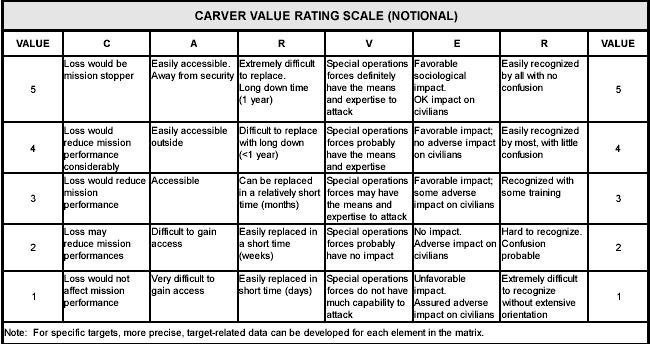Attack the weak points with the CARVER Matrix: QMN032
Martial Mental Models: The Quartermaster, Friday, 7 June
(Today’s report is a 4 minute read)
BLUF: The CARVER Matrix is a simple means of prioritizing targets given the resources on hand. It's used as a way to draw on both qualitative and quantitative information to identify weaknesses in the enemy’s infrastructure. Chris explains it in a short historical example.
Chris here. The greatest value a Green Beret can bring to American business is a mindset around achieving the maximum possible outcomes with the minimum possible inputs – but as always, identifying the right place to focus one’s energy is far more challenging than the act itself. Green Berets uniquely think about how to achieve network, secondary, and downstream effects on a given system by learning how to focus on key terrain, individuals, or nodes inside a system with high dependency or interconnectivity. This skillset is invaluable as businesses and markets increase in both complexity as well as interdependency.
Earlier this week I talked about the CARVER Matrix as an example of a mental framework. CARVER stands for Criticality, Accessibility, Recuperability, Vulnerability, Effect and Recognizability. It was developed in WWII by the OSS for French resistance fighters as a simple means of prioritizing targets given the resources on hand. It's used as a way to draw on both qualitative and quantitative data to identify weaknesses in the enemy’s infrastructure. Along with other models like COO/MCOO – more on that on another day – the CARVER helps the Green Beret identify weak spots in the enemy’s infrastructure that can be attacked with catastrophic effects.

In Europe during the war, a French irregular might not have access to bombers and cavalry, but he has local knowledge; he may know that a certain supply train crosses a certain bridge on a regular basis, and a small charge placed on the right girder could weaken the bridge enough to fall, slowing supplies to front line Germans. He also knows a nearby factory is producing rations for the Germans; could poisoning the flour or intimidating the factory workers be effective in damaging those resources? And which of these two targets will have the maximum possible effects for the minimum possible inputs?
Using CARVER our freedom fighter thinks about the Criticality of each, and ranks them. Is the train the only supply line for miles and miles? Is the bridge Accessible without being detected? Can the bridge be easily Recuperated? How Vulnerable is it to a small amount of dynamite? Will the overall Effect set the enemy back, or can they simply re-route their supply line? How Recognizable and thus demoralizing will it be for the enemy if this bridge were to be wrecked?
The freedom fighter gives a value to each element, and compares it to similar considerations for the factory, and compares the totals. If the factory course of action wins out, then he should prioritize that target and save the bridge for another day.
CARVER has been applied in business in the same way today by cybersecurity firms and consultancies like BoozAllenHamilton; the goal in business is to identify critical aspects of the competition – or one’s own infrastructure and business landscape. (CPP)
LONELINESS EPIDEMIC: CAUSE & EFFECT: Alone (12 min) “In translating family formation into a strictly private matter, the SDT whistled past a critical fact of our history—namely, that kinship has been the most powerful glue of human groups since Homo sapiens first discovered the mother-in-law. Evolutionary psychologists have a compelling theory about why: humans practiced “reciprocal altruism” in relation to kin because they had a stake in the reproductive success of their genetic relations. Even evolutionary-psychology skeptics, though, might notice that though marriage has shape-shifted over the centuries and across cultures, it has always defined those people—spouses, parents, children, grandparents, siblings, in-laws—to whom we owe special attention and mutual protection. That would explain why cohabiting couples, even those with children, don’t have the same support from extended family as married couples with children. Marriage creates kin; cohabitation does not.” (BJM)
ITS ALL JUST DATA: Alexa, Where's My Privacy? Amazon Reportedly Developing Emotion-Detecting Wearables (2 min) “According to Bloomberg, who based the article on an anonymous source, "internal documents reviewed by Bloomberg," and two patents, the device – code-named Dylan – is a smart-phone compatible AI wearable equipped with microphones and software that analyzes a user's voice for emotional data. Bloomberg's source claims that the device is currently being tested, at least to some degree. "A beta testing program is underway," Bloomberg reports, "though it's unclear whether the trial includes prototype hardware, the emotion-detecting software or both.” (KSA)
Remarks Complete. Nothing Follows.
KS Anthony (KSA), Chris Papasadero (CPP) & Brady Moore (BJM)


